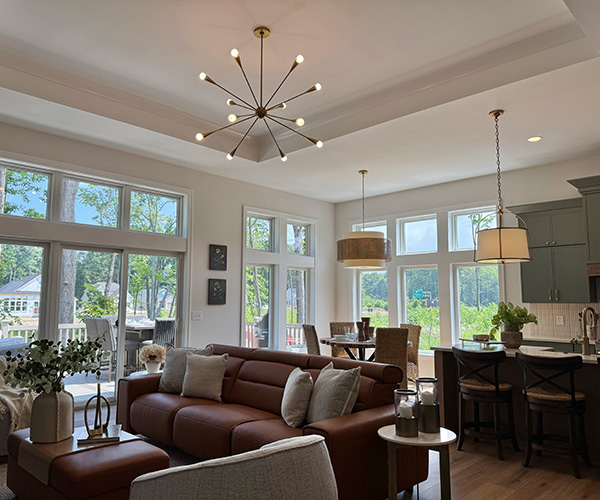The sunlight sold the Fischbacks on their revamped split-level bungalow. "You get every single bit of sun ray," says Beverly Maloney-Fischback of the large kitchen windows in the Rocky River home. "We figured we could spend the rest of our lives watching the sunset and never get tired of it."
That vision sustained the couple during the six months they spent renovating the house they bought in 2012. As founder and publisher of Organic Spa magazine, Beverly and husband David — the president and co-chair of the Krill Co., a Cleveland-based commercial builder — live an active and sustainable lifestyle. They wanted their new home to reflect these values, including a focus on conservation.
As they embarked on renovating the space, which was originally built in 1953, the couple wanted to preserve as much of its original foundation and first floor as possible. "We saw no reason to tear down what was still functioning and of value," says Beverly.
The Fischbacks' residence was typical of many of the small, sturdy houses built in Cleveland in the '50s. Veterans returning home from World War II could get a mortgage for no money down, and bungalows "were the main housing product of the era," says Tom Bier, a senior fellow at the Maxine Goodman Levin College of Urban Affairs at Cleveland State University.
Typically, bungalows were one-story homes with two bedrooms, a bathroom, kitchen and living room, says Bier. The walls were constructed with plaster and wood made of a heartier stock than today.
Working with Lakewood-based architectural firm AODK Inc., the Fischbacks were able to preserve many of the original '50s flourishes of their home, including the two-sided, marble-encased fireplace that opens from the living room to the dining room, the wood staircase leading from the first to second floor and the front-room bay windows that look out over Lake Erie.
But the upstairs needed to be gutted, due to structural problems. When re-envisioning the space, the couple decided they wanted the layout to feel open and airy.
A large yoga room with heat-reflecting windows was added at the top of the stairs. "I meditate and practice [yoga] most days," Beverly says. "This room was an important addition for me."
The master bathroom also became a focal point of the upstairs redesign. The tranquil, off-white room with white ceramic tiles, an oversided oval soaking tub and floating shelves that hold large seashells has a Zenlike feel to it.
From the solar panels on the windowpanes that help power the electric blinds to the bedroom fireplace that runs on bioethanol made from sugar cane, the Fischbacks designed every element to be as energy efficient as possible.
But for them, it all comes back to those sunsets. On a recent night, the duo sat at their kitchen stools watching as the sun sank slowly into the pink sky.
Adding On
The little things often determine the success or failure of home additions, says David Krebs, owner of AODK Inc., a Lakewood-based architectural design firm. Consider the following before swinging that sledgehammer.
LIGHTING. Since additions have the capacity to add or block light, consider your current sources of natural light. "This determines whether you need to add a skylight or how high you should place a new window," he says.
STYLE. Study other homes in the area before plotting out your exterior renovations. "A lot of people are interested in making an older house more contemporary," Krebs says. "But you have to think about the character of the other houses on the street and whether the city has any restrictions on the style of renovations that can be done."
SPACE. Before you get too excited about adding that new deck, it's important to understand your property lines and restrictions. "A lot of design decisions depend on property setbacks," Krebs warns. "With some houses, you physically can't build any closer to the neighbor's home."



